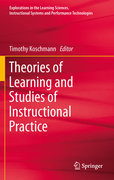
This is a book about an attempt to change the way math was taught in a particular classroom. Its title plays on our everyday usage of the terms theory and practice . In education, these terms are conventionally treated oppositionally—we have theories about what we should do and we have what teachers actually do do. In this way, theory stands prior, logically and chronologically, to practice; practice inevitably becoming theory’s imperfect realization. We seek in this volume, however, to develop a different stance with regard to the relationship between the two. Taking the details of instructional practice as our principle object of study, we explore what role theories of learning might play in illuminating such practices. The book is about actual practices by which teaching is done and how contemporary theories of learning might help us understand those practices. It seeks to provide a foundation for future practice-basedinquiry in education, by addressing the methodological question: How do we goabout studying instructional practice in a principled way? " Organized into position papers, commentaries, responses, and synthesis chapters, facilitating a dialogic structure Grounds discussion into a common stet of material leadingto collaborative analysis Includes primary data (transcripts, exhibits, images) INDICE: Section I: Introductions.- Ch 1: Theorizing Instructional Practice.- Ch 2: Invention in the Classroom: Structuring Natural Variability as Distribution.- Appendix A: Transcription conventions.- Appendix B: Classroom excerpts.- Section II: The Situated Action Perspective.- Ch 3: A Situative Perspective on Cognition and Learning in Interaction.- Ch 4: A Commentary on Incommensurate Programs.- Ch 5: Representational Competence: A Commentary.- Ch 6: The Interaction of Content and Control in Group Problem Solving and Learning.- Ch 7: Working Both Sides.- Responses to the Commentaries by Jim Greeno.- Section III: A Dialogic Theory of Learning.- Ch 8: Saying More Than You Know in Instructional Settings.- Ch 9: Schooling: Domestication or Ontological Construction?- Ch 10: Developing Fluency versus Conceptual Change.- Ch 11: From Dialectic to Dialogic.- Ch 12: Vygotsky and Teacher Education in the Knowledge Age.- Responses to the Commentaries by Jim Wertsch and Sibel Kazak.- Section IV: Transactional Inquiry.- Ch 13: A Transactional Perspective on the Practice-Based Scienceof Teaching and Learning.- Ch 14: On Plants and Textual Representations of Plants: Learning to Reason in Institutional Categories.- Ch 15: Contributions ofthe Transactional Perspective to Instructional Design and the Analysis of Learning in Social Context.- Ch 16: Transacting with Clancey’s “Transactional Perspective on the Practice-Based Science of Teaching and Learning.”- Ch 17: Making Sense of Practice in Mathematics: Models, Theories and Disciplines.- Responses to the Commentaries by Bill Clancey.- Section V: Synthesis.- Ch 18: Observations on the Observations.- Ch 19: Cultural Forms, Agency, and the Discovery of Invention in Classroom Research on Learning and Teaching.- Ch 20: Reflections on Practice, Teaching/Learning, Video, and Theorizing.- Ch 21: Does “Learning” Exist?
- ISBN: 978-1-4419-7581-2
- Editorial: Springer
- Encuadernacion: Cartoné
- Páginas: 538
- Fecha Publicación: 30/11/2010
- Nº Volúmenes: 1
- Idioma: Inglés
